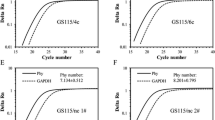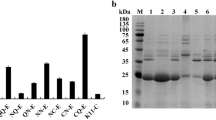Abstract
Proteases are one of the most innovative products used to improve the efficiency of feed additives. Due to their hydrolytic properties, they enhance the absorption of amino acids, which can reduce the protein content and the cost of feeds. The subtilisin-like proteinase of Bacillus pumilus 3–19 is a promising candidate for industrial use as a feed additive. However, in order to obtain a high yield of the enzyme, it is necessary to develop a highly efficient expression system. The aim of the study was to obtain stable expression of the optimized B. pumilus 3–19 protease gene in the Pichia pastoris expression system and evaluate the correlation of enzyme activity with the choice of vector type and signal peptides. The efficient secretion of subtilisin-like protease into the culture fluid of the recombinant yeast strains was confirmed. The study showed that the incubation time affects the synthesis of protease in P. pastoris, and the maximum activity of the enzyme was observed at 72 h of growth of the yeast culture. Yeast strains with constructs based on the low-copy vector pPINK-LC showed higher protease activity (U/mL) in the hydrolysis of azocasein (2.63 ± 0.16 for killer signal peptide (SP), 2.49 ± 0.08 for α-mating factor presequence, 2.19 ± 0.11 for lysozyme SP) than strains with constructs based on the pPINK-HC vector (1.86 ± 0.09 for killer SP, 2.21 ± 0.07 for α-mating factor presequence, 1.31 ± 0.11 for lysozyme SP), regardless of which signal peptide was used. The ability of the recombinant protease to hydrolyze a specific substrate confirms that the enzyme is a member of the subtilisin family. The maximum protease activity was obtained for yeast strains with pPINK-LC-killer-aprBp (5.75 ± 0.08 U/mL) and pPINK-LC-α-mat.factor-aprBp (4.33 ± 0.07 U/mL) constructs. This study demonstrated that the subtilisin-like protease from recombinant P. pastoris strains exhibits proteolytic activity, which depends on the incubation time and the choice of signal peptide and vector. The production of bacillary protease by the heterologous yeast-based expression system makes this system promising for the development of new feed additives for animal husbandry.






Similar content being viewed by others
Data Availability
Not applicable.
Code Availability
Not applicable.
References
Kim, S. W., Less, J. F., Wang, L., Yan, T., Kiron, V., Kaushik, S. J., & Lei, X. J. (2019). Meeting global feed protein demand: Challenge, opportunity, and strategy. Annual Review of Animal Biosciences, 7, 221–243. https://doi.org/10.1146/annurev-animal-030117-014838
Verstraete, W., & De Vrieze, J. (2017). Microbial technology with major potentials for the urgent environmental needs of the next decades. Microbial Biotechnology, 10, 988–994. https://doi.org/10.1111/1751-7915.12779
Law, F. L., Zulkifli, I., Soleimani, A. F., Liang, J. B., & Awad, E. A. (2017). The effects of low-protein diets and protease supplementation on broiler chickens in a hot and humid tropical environment. Asian-Australas Journal of Animal Sciences, 31, 1291–1300. https://doi.org/10.5713/ajas.17.0581
Rani, K., Rana, R., & Datt, S. (2012). Review on latest overview of proteases. International Journal of Current Life Sciences, 2, 12–18.
Gong, L., Wang, B., Mei, X., et al. (2018). Effects of three probiotic Bacillus on growth performance, digestive enzyme activities, antioxidative capacity, serum immunity, and biochemical parameters in broilers. Animal Science Journal, 89, 1561–1571. https://doi.org/10.1111/asj.13089
Toghyani, M., Girish, C. K., Wu, S. B., Iji, P. A., & Swick, R. A. (2017). Effect of elevated dietary amino acid levels in high canola meal diets on productive traits and cecal microbiota population of broiler chickens in a pair-feeding study. Poultry Science, 96, 1268–1279. https://doi.org/10.3382/ps/pew388
Goodarzi Boroojeni, F., Senz, M., Kozłowski, K., Boros, D., Wisniewska, M., Rose, D., et al. (2017). The effects of fermentation and enzymatic treatment of pea on nutrient digestibility and growth performance of broilers. Animal, 11, 1698–1707. https://doi.org/10.1017/S1751731117000787
Oxenboll, K. M., Pontoppidan, K., & Fru-Nji, F. (2011). Use of a protease in poultry feed offers promising environmental benefits. International Journal of Poultry Science, 10, 842–848. https://doi.org/10.3923/ijps.2011.842.848
Williams, R. B. (2005). Intercurrent coccidiosis and necrotic enteritis of chickens: Rational, integrated disease management by maintenance of gut integrity. Avian Pathology, 34, 159–180. https://doi.org/10.1080/03079450500112195
Mikhailova, E. O., Mardanova, A. M., Balaban, N. P., Rudenskaya, G. N., & Sharipova, M. R. (2007). Isolation and characterization of a subtilisin-like proteinase of Bacillus intermedius secreted by the Bacillus subtilis recombinant strain AJ73 at different growth stages. Biochemistry, 72, 192–198. https://doi.org/10.1134/S0006297907020095
Cobb, R. E., Si, T., & Zhao, H. (2012). Directed evolution: An evolving and enabling synthetic biology tool. Current Opinion in Chemical Biology, 16, 285–291. https://doi.org/10.1016/j.cbpa.2012.05.186
Li, Q., Yi, L., Marek, P., & Iverson, B. L. (2013). Commercial proteases: Present and future. FEBS letters, 587, 1155–1163. https://doi.org/10.1016/j.febslet.2012.12.019
Ahmad, M., Hirz, M., Pichler, H., & Schwab, H. (2014). Protein expression in Pichia pastoris: Recent achievements and perspectives for heterologous protein production. Applied Microbiology and Biotechnology, 98, 5301–5317. https://doi.org/10.1007/s00253-014-5732-5
Weidner, M., Taupp, M., & Hallam, S. J. (2010). Expression of recombinant proteins in the methylotrophic yeast Pichia pastoris. Journal of Visualized Experiments, 36, 1862. https://doi.org/10.3791/1862
Laemmli, U. (1970). Cleavage of structural proteins during the assembly of the head of bacteriophage T4. Nature, 227, 680–685. https://doi.org/10.1038/227680a0
Demidyuk, I. V., Romanova, D. V., Nosovskaya, E. A., Chestukhina, G. G., Kuranova, I. P., & Kostrov, S. V. (2004). Modification of substrate-binding site of glutamyl endopeptidase from Bacillus intermedius. Protein Engineering, Design and Selection, 17, 411–416. https://doi.org/10.1093/protein/gzh050
Wang, J. R., Li, Y. Y., Liu, D. N., Liu, J. S., Li, P., Chen, L. Z., & Xu, S. D. (2015). Codon optimization significantly improves the expression level of α-amylase gene from Bacillus licheniformis in Pichia pastoris. BioMed Research International, 8, 1–9. https://doi.org/10.1155/2015/248680
Lin-Cereghino, G. P., Stark, C. M., Kim, D., et al. (2013). The effect of α-mating factor secretion signal mutations on recombinant protein expression in Pichia pastoris. Gene, 519, 311–317. https://doi.org/10.1016/j.gene.2013.01.062
Yang, M., Teymorian, S., Olivares, P., & Murthy, P. P. N. (2015). Extracellular expression of alkaline phytase in Pichia pastoris: Influence of signal peptides, promoters and growth medium. Biotechnology Reports (Amsterdam, Netherlands), 6, 112–118. https://doi.org/10.1016/j.btre.2015.03.005
Vogl, T., Gebbie, L., Palfreyman, R. W., & Speight, R. (2018). Effect of plasmid design and type of integration event on recombinant protein expression in Pichia pastoris. Applied and Environment Microbiology, 84, e02712-e2717. https://doi.org/10.1128/AEM.02712-17
Du, M., Battles, M. B., & Nett, J. H. (2012). A color-based stable multi-copy integrant selection system for Pichia pastoris using the attenuated ADE1 and ADE2 genes as auxotrophic markers. Bioeng Bugs, 3, 32–37. https://doi.org/10.4161/bbug.3.1.17936
Cregg, J. M., Cereghino, J. L., Shi, J., & Higgins, D. R. (2000). Recombinant protein expression in Pichia pastoris. Molecular Biotechnology, 16, 23–52. https://doi.org/10.1186/1475-2859-11-22
Acknowledgements
This work was performed in accordance with the Russian Government Program of Competitive Growth of Kazan Federal University.
Funding
This work was supported by the Russian Science Foundation (Project No. 16–16-04062).
Author information
Authors and Affiliations
Contributions
DP and YV conducted cloning of the gene encoding a B. pumilus 3–19 protease and performed an analysis of protease expression. DP prepared the manuscript. MS developed the study concept and contributed materials for analyses. All authors were involved in editing the manuscript and read and approved the submitted version.
Corresponding author
Ethics declarations
Conflict of Interest
None.
Ethics Approval
Not applicable.
Informed Consent
None.
Consent for Publication
Not applicable.
Additional information
Publisher’s Note
Springer Nature remains neutral with regard to jurisdictional claims in published maps and institutional affiliations.
Rights and permissions
About this article
Cite this article
Pudova, D.S., Vasilyeva, Y.A. & Sharipova, M.R. Heterologous Expression of Bacillus pumilus 3–19 Protease in Pichia pastoris and Its Potential Use as a Feed Additive in Poultry Farming. BioNanoSci. 11, 989–997 (2021). https://doi.org/10.1007/s12668-021-00899-2
Accepted:
Published:
Issue Date:
DOI: https://doi.org/10.1007/s12668-021-00899-2




